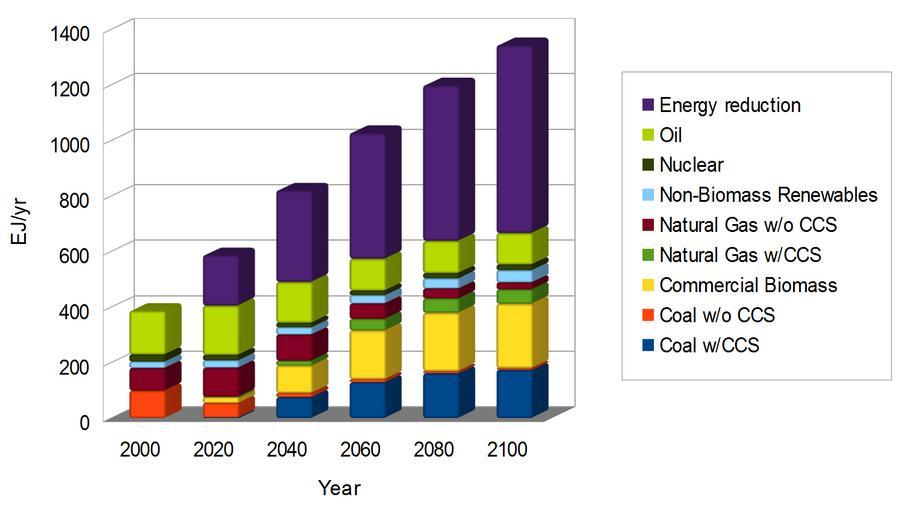MAKE A MEME
View Large Image

| View Original: | Projected global primary electricity consumption by source, over the 21st century, for a climate change mitigation scenario.png (1508x850) | |||
| Download: | Original | Medium | Small | Thumb |
| Courtesy of: | commons.wikimedia.org | More Like This | ||
| Keywords: Projected global primary electricity consumption by source, over the 21st century, for a climate change mitigation scenario.png electricity consumption PEC by source over the 21st century It is based on a climate change mitigation scenario in which anthropogenic i e human greenhouse gas emissions are substantially reduced over the century The graph shows how a variety of energy sources contribute to PEC It also shows how energy consumption is reduced compared to a reference scenario in which no efforts are made to reduce greenhouse gas emissions In the scenario PEC increases over time from 387 exajoules EJ in 2000 to 666 EJ in 2100 Energy savings contribute significantly to reductions in energy use compared to the reference scenario In the reference scenario PEC increases from 387 EJ in 2000 to 1344 EJ in 2100 The graph shows that fossil fuels dominate PEC in 2000 By 2060 most coal is used with carbon capture and storage CCS with a increase in the share of PEC supplied by commercial biomass In 2100 the percentage contributions to PEC are energy reductions 51; coal with CCS 13; coal without CCS 0 4; commercial biomass 17; natural gas with CCS 3 8; natural gas without CCS 1 9; non-biomass renewables 3 3; nuclear power 1 5; oil 8 4 Data Data for the mitigation scenario are summarized below The full set of data are provided in a later section as comma-separated values CSV The data below summarizes PEC by source in EJ Energy reductions in the mitigation scenario are equal to total PEC in the reference scenario minus total PEC in the mitigation scenario Data are provided for the years 2000 2050 and 2100 respectively Energy reduction 0 0 394 5 677 6 Coal w/CCS 0 0 106 8 173 6 Coal w/o CCS 98 9 12 3 5 8 Commercial Biomass 0 0 147 5 232 6 Natural Gas w/CCS 0 0 33 0 51 5 Natural Gas w/o CCS 81 8 71 1 24 9 Non-Biomass Renewables 22 5 26 6 44 0 Nuclear 25 6 16 1 20 5 Oil 158 1 121 9 113 1 Total reference scenario 386 9 929 8 1343 7 Total mitigation scenario 386 9 535 3 666 1 The following data shows the percentage contribution of sources to total PEC Data are provided for the years 2000 2050 and 2100 respectively Energy reduction 0 0 42 4 50 4 Coal w/CCS 0 0 11 5 12 9 Coal w/o CCS 25 6 1 3 0 4 Commercial Biomass 0 0 15 9 17 3 Natural Gas w/CCS 0 0 3 6 3 8 Natural Gas w/o CCS 21 1 7 6 1 9 Non-Biomass Renewables 5 8 2 9 3 3 Nuclear 6 6 1 7 1 5 Oil 40 9 13 1 8 4 Data sources Scenario data are taken from Clarke et al 2007 <ref name clarke data > https //web archive org/web/20130616054921/http //www climatescience gov/Library/sap/sap2-1/finalreport/CCSP-2-1A-Scenario-Information-070707 xls CCSP-2-1A-Scenario-Information-070707 xls in harvnb Clarke others 2007 </ref> The graph is based on the IGSM_REF reference and IGSM_Level1 mitigation scenarios Data from Clarke et al 2007 <ref name clarke data /> are in the public-domain and are included in a following section The report by Clarke et al 2007 <ref> Figure 4 10 in Chapter 4 Stabilization Scenarios in Clarke others 2007 103 </ref> includes a graph similar to this one Notes reflist References citation CITEREFClarkeothers2007 Clarke L et al July 2007 Scenarios of Greenhouse Gas Emissions and Atmospheric Concentrations Sub-report 2 1A of Synthesis and Assessment Product 2 1 by the U S Climate Change Science Program and the Subcommittee on Global Change Research Department of Energy Office of Biological Environmental Research Washington DC USA http //library globalchange gov/products/assessments/2004-2009-synthesis-and-assessment-products/sap-2-1a-scenarios-of-greenhouse-gas-emissions-and-atmospheric-concentrations own Enescot 2013-10-07 Greyscale version Comma-separated values Data were exported from OpenOffice org 4 0 0 Calc as comma separated values csv The following options were used Character set Western Europe 1252 Field delimiter Text delimiter Quote all text cells no Save cell content as shown yes Fixed column width no <pre> 2000 2020 2040 2060 2080 2100 Coal w/CCS 0 1 8726625295 75 444508718 129 1418011217 161 2538170578 173 6080558426 Coal w/o CCS 98 8551419634 52 5763595296 14 7533997718 10 6949287477 7 8754730012 5 8328272264 Commercial Biomass 0 20 6083814814 99 0391793264 176 0803406657 210 4123076545 232 6318594815 Natural Gas w/CCS 0 1 5101981599 17 1928804846 41 4536597029 51 1393522238 51 5289485318 Natural Gas w/o CCS 81 7896749777 105 2241810432 94 7490924601 55 8540853312 36 0936516819 24 8688375282 Non-Biomass Renewables 22 4833651954 25 7664179053 25 7110203361 29 253511178 36 4853378946 44 045134245 Nuclear 25 5985811645 19 5501420401 16 2462719057 16 8718264901 18 7264128277 20 4973853194 Oil 158 145950192 178 1305902789 146 8464751178 114 2820116004 115 9689587686 113 0792083141 Energy reduction -0 000000048 181 9869034265 330 6765460279 454 2481828487 561 2932891661 677 6003453143 </pre> Global warming graphs Electricity graphs Cc-zero | ||||